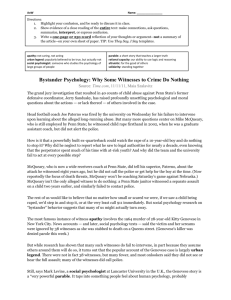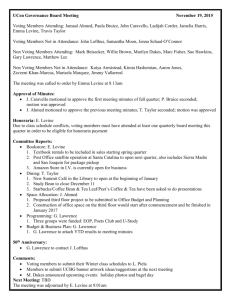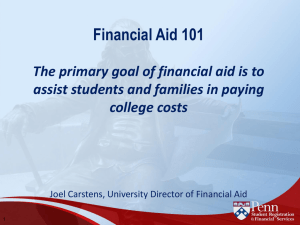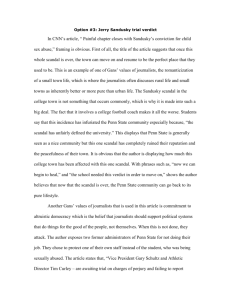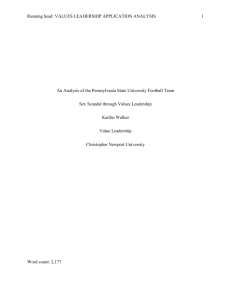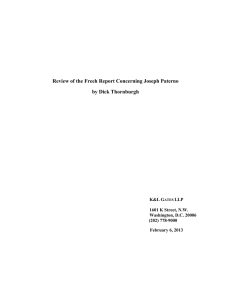Bystander Psychology: Why Some Witnesses to Crime Do Nothing
advertisement
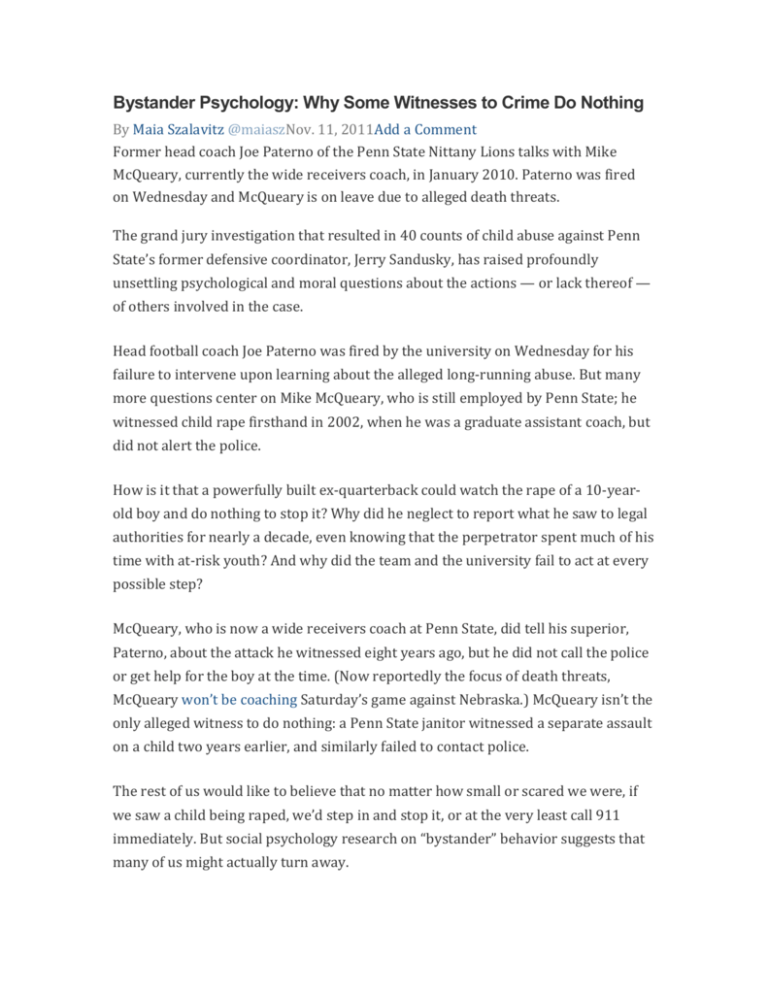
Bystander Psychology: Why Some Witnesses to Crime Do Nothing By Maia Szalavitz @maiaszNov. 11, 2011Add a Comment Former head coach Joe Paterno of the Penn State Nittany Lions talks with Mike McQueary, currently the wide receivers coach, in January 2010. Paterno was fired on Wednesday and McQueary is on leave due to alleged death threats. The grand jury investigation that resulted in 40 counts of child abuse against Penn State’s former defensive coordinator, Jerry Sandusky, has raised profoundly unsettling psychological and moral questions about the actions — or lack thereof — of others involved in the case. Head football coach Joe Paterno was fired by the university on Wednesday for his failure to intervene upon learning about the alleged long-running abuse. But many more questions center on Mike McQueary, who is still employed by Penn State; he witnessed child rape firsthand in 2002, when he was a graduate assistant coach, but did not alert the police. How is it that a powerfully built ex-quarterback could watch the rape of a 10-yearold boy and do nothing to stop it? Why did he neglect to report what he saw to legal authorities for nearly a decade, even knowing that the perpetrator spent much of his time with at-risk youth? And why did the team and the university fail to act at every possible step? McQueary, who is now a wide receivers coach at Penn State, did tell his superior, Paterno, about the attack he witnessed eight years ago, but he did not call the police or get help for the boy at the time. (Now reportedly the focus of death threats, McQueary won’t be coaching Saturday’s game against Nebraska.) McQueary isn’t the only alleged witness to do nothing: a Penn State janitor witnessed a separate assault on a child two years earlier, and similarly failed to contact police. The rest of us would like to believe that no matter how small or scared we were, if we saw a child being raped, we’d step in and stop it, or at the very least call 911 immediately. But social psychology research on “bystander” behavior suggests that many of us might actually turn away. The most famous instance of witness apathy involves the 1964 murder of 28-yearold Kitty Genovese in New York City. News accounts — and later, social psychology texts — said the victim and her screams were ignored by 38 witnesses as she was stabbed to death on a Queens street. (Genovese’s killer was denied parole this week.) But while research has shown that many such witnesses do fail to intervene, in part because they assume others around them will do so, it turns out that the popular account of the Genovese case is largely urban legend. There were not in fact 38 witnesses, but many fewer, and most onlookers said they did not see or hear the full assault; many of the witnesses did call police. Still, says Mark Levine, a social psychologist at Lancaster University in the U.K., the Genovese story is a “very powerful parable. It taps into something people feel about human psychology, probably mistakenly: that somehow, when we’re with other people, we lose our rational capacity or personal identity, which controls our behavior.” Levine, who first brought to the public’s attention the problems with the Genovese case accounts, says that group dynamics do influence our actions, but not exactly the way we think. His own research has shown that being with others doesn’t always — or even typically — reduce altruistic behavior. However, the type of group we’re in and the relationships we have with its members, and with outsiders, do tend to influence how likely or unlikely we may be to help. When the actions of a group are public and visible, insiders who behave in an unacceptable way — doing things that “contravene the norms of the group,” Levine says — may actually be punished by the group more harshly than an outsider would be for the same behavior. “It’s seen as a threat to the reputation of the group,” says Levine. In contrast, when the workings of a group are secretive and hidden — like those of a major college football team, for instance, or a political party or the Catholic priesthood — the tendency is toward protecting the group’s reputation by covering up. Levine suggests that greater transparency in organizations promotes better behavior in these situations. “It’s the norms and the values of the group that are important,” Levine says, noting that this fact doesn’t reflect very well on Penn State. Indeed, the riot that broke out after the firing of revered coach Paterno — who appears to have covered up for his former colleague, Sandusky, or at least looked the other way, rather than reporting him to the police — suggests that group solidarity with the football team still takes priority over support for abused children at the school. Another factor that may have prevented action by McQueary and others is denial. Social psychologist Stanley Cohen identified several forms of denial that may cause people to ignore atrocities. There’s the denial that commonly occurs in response to difficult situations like receiving a cancer diagnosis or becoming addicted to drugs: the simple repressing of information and refusal to admit that the problem exists or has occurred. In McQueary’s case, however, there seems to have been another type of denial at play, which Cohen labeled “interpretative.” “You don’t deny that something happened, but try to transform the meaning of it,” says Levine, explaining that a witness might minimize the significance of a crime or try to see it as something other than it was. McQueary may well have been psychologically unable to accept that a man like Sandusky, someone he admired, had actually committed the abhorrent crime he witnessed. Research suggests that when people are faced with situations that threaten their view of the world as relatively fair and decent, rather than revising their own perspective, they often create accounts that deny reality, blame the victim or otherwise rationalize the situation. In my own reporting, I’ve seen this many times in parents who send their children to “troubled teen” programs. These largely unregulated programs, which purport to rehabilitate teens with drug and behavioral problems, are associated with thousands of accounts of abuse and neglect, according to aninvestigation [PDF] by the Government Accountability Office. But many parents refuse to believe their own children’s claims of such abuse or minimize their seriousness — even when the abuse is officially documented — because it would be psychologically too painful for them to believe that their choice to send their children to the program caused harm. Indeed, a key reason that child sex abuse often stays hidden is that it is difficult for people to accept that a trusted authority figure or loved one could do something so awful. (LIST: Six Ways Joe Paterno Infiltrated Penn State Culture) A third factor that influences the likelihood that people will intervene in violence is whether they feel their actions will be supported by others in the community around them. Levine studied the case of James Bulger, a 2-year-old who was kidnapped, sexually assaulted and murdered by two older boys in 1990 in Liverpool. Many witnesses saw the boys with the bleeding toddler, but since the boys claimed to be the victim’s brothers, no one confronted them. The group norm in modern society in the U.K. — and in the U.S. — is that you don’t get involved in other families’ business. “They used to say in the ’50s that children were ‘everbody’s children,'” says Levine. “Adults took responsibility for all children, rather than, ‘I take responsibility for mine and you take responsibility for yours.'” But these days, each family stands on its own. Such narrowly drawn lines of responsibility prevent intervention by outsiders, because people feel they will not be supported and may even be condemned for stepping in. Indeed, in our culture, it’s considered taboo for outsiders to involve themselves in most family matters. In contrast, in Sweden, hitting children was made illegal in 1979 and the rights of the child are considered in that culture to supersede those of the family. If someone is seen hitting a child on the street, other parents can and often will try to stop the harm. While it is not clear exactly how the norms or values of Penn State may have affected the lack of action by its leadership in response to such vile abuse, it is clear that something went very wrong. A pedophile should not have been allowed to operate with impunity, especially after having been caught in the act twice. Understanding the psychology of these situations can help increase the chances that bystanders will step up when people need assistance, but it does not excuse the failures of those who do nothing. 1) Should bystanders be held accountable for the crimes they witness? 2) Are there other reasons bystanders sometimes don’t report crimes? 3) What is your level of support for the ousting of Paterno? 4) In your own words, write the definition of Bystander Psychology. Psychology: 200-205 Maia Szalavitz is a health writer at TIME.com. http://healthland.time.com/2011/11/11/bystander-psychology-why-some-witnessesto-crime-do-nothing/2/
